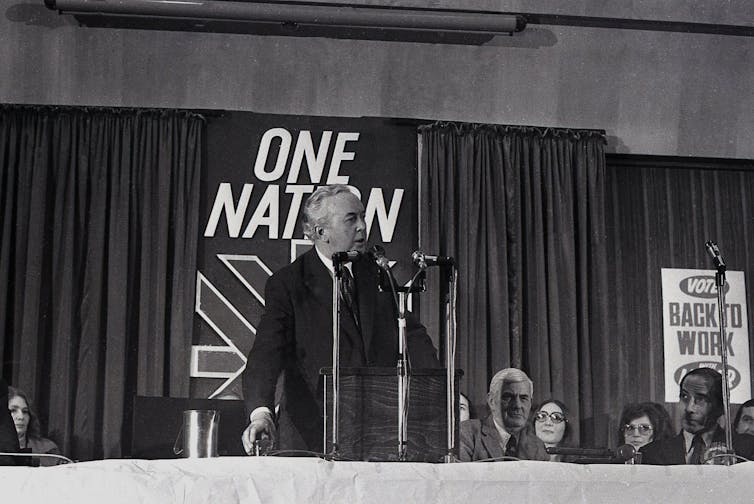Is Labour ready for government? This question is being asked regularly of the public by pollsters YouGov, especially as the UK approaches the general election on July 4. For many, the answer is a measure of the extent to which Keir Starmer has changed the party since he became leader.
The idea is that if a leader can modernise their party via policy review and personnel changes, then they could similarly change and improve the country. It is, effectively, a test of leadership skills, alongside a demonstration that they can stamp their authority on their party.
To determine whether Starmer has sufficiently demonstrated this leadership skill, we can briefly look back at how Tony Blair and David Cameron modernised their parties before entering government. Has Starmer also engaged in such deep renewal while in opposition?

Want more election coverage from The Conversation’s academic experts? Over the coming weeks, we’ll bring you informed analysis of developments in the campaign and we’ll fact check the claims being made. Sign up for our new, weekly election newsletter, delivered every Friday throughout the campaign and beyond.
Rhetorically speaking, the importance of the idea of wholesale change led from the centre is designed to create a narrative following a previous defeat. In essence, it is a story told by the leadership of how they accepted defeat but have now reflected and changed in response. For Blair and Cameron, it was about understanding what message the public was sending when they decided not to vote for them.
Blair interpreted the 1992 defeat as a message that voters did not yet trust the Labour party with the powers of government. The party was seen as lacking preparedness and as not sharing the values of the post-Thatcher electorate. They feared that, at heart, Labour was still prone to nationalisation, which risked reversing the Thatcher reforms of the 1980s.
Cameron interpreted his party’s 2005 defeat as a signal that the Conservative party needed to take its divisions seriously, move beyond the debates and divisions over Europe, and embrace certain aspects of social liberalism. By doing so, Cameron aimed to show the Conservatives were not a risk to the socially liberal country.
Both leaders, therefore, took the defeats their party endured as a sign that they had to change to become compatible with the values of the country and, in turn, the high offices of power which they sought.
In preparation for the election ahead, Starmer has been at pains to show how his party has changed since its 2019 defeat. For Starmer, this is about disowning Jeremy Corbyn and Corbynism by portraying his leadership as a more mature and sensible alternative.
Labour’s most successful renewal projects
Historically, Labour renewal projects have been about moving beyond the perception that it was an out-of-date, ideologically driven party. Those leaders who have aimed to change the narrative have sought to show that Labour not only accepted the modern world, but in fact embraced it and could lead from the front by embedding social democracy within it. Harold Wilson attempted this with the rhetoric of “scientific socialism” during his white heat of technology speech in 1963.
Blair controversially reformed clause four of the Labour party constitution to signal that he was moving the party away from socialism. It changed the party’s identity beyond recognition, but Blair’s aim was to show that the party he led had been reformed and could be trusted.

Starmer’s problem is that he lacks a clear indicator of a similarly substantive change.
Despite this, his arguments seek to portray Labour as a modern party that has changed in opposition and is now ready to address the problems of the modern world. For example, dealing with economic reconstruction following the COVID legacy, as well as accepting that Brexit and its consequences are facts of life, while promising reforming ties with the European Union.
A key part of embracing this reality has been the acceptance that the fiscal position of the UK will be challenging, leaving Labour with tough decisions over spending priorities – something that was less of a concern for Blair in 1997.
Part of the problem facing Starmer is the perception that he reverses on key pledges. He may announce large projects such as reforms of social care, the House of Lords, and mental health but the public feel unsure of whether he would then water them down or reverse entirely due to the fiscal concerns. This is not a luxury he can not afford during an election campaign.
This tendency risks creating confusion among voters, who may lose sight of the overarching message of change and renewal. Indeed, the reversals risk creating the perception that Labour is simply testing ideas on the voter before deciding to go another route.
The consequence of this is that it puts Labour’s credibility into question. It appears uncertain what they stand for. Consistency is a key part of presenting a credible governing agenda ahead of an election.
Meanwhile, across the aisle
However, if we were to conclude that Labour was not yet ready for government, we need to contextualise this against the position of the Conservatives. The Tories have been in office for 14 turbulent years, first presiding over austerity, then the Scottish independence referendum, Brexit, and COVID.
Since the last general election, they have had three different leaders (five since 2015), with one being the shortest in history.
It has not been an easy period of office and there are signs that global conflict will bedevil whoever takes office after the July election. But the key point here is the Conservatives are suffering from an absence of innovation, a lack of internal cohesion, fluctuating leadership, and a sense that it is time for a change.
Put simply, the Conservatives have become less fit for office than the Labour party because of this sense of leadership fatigue and policy vacuum.
The lack of consistency in his message still clouds Starmer’s attempts to convince voters that he should be prime minister, even if they can sense a change in tone and attitude from the Corbyn years. However, the degeneration of the Conservatives suggests that their road takes them back to the opposition benches, regardless.

